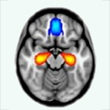Tuesday, 30 June 2015
The Physiology of Expanded Consciousness

The results of some studies are exactly what you would have predicted, but that doesn’t make them any less interesting. For example, the study reported in the link below found that taking psilocybin (the psychoactive substance in “magic mushrooms”) puts the brain in a state that is conducive to freer associations, somewhat as in dreams.
So no big surprise there. But the researchers still had to use some ingenious methods to demonstrate this finding: a combination of functional magnetic resonance imaging with an original technique for measuring entropy in the activity of various networks in the brain. But it’s when you examine the results a bit more closely that the whole beauty of this study emerges. The researchers found a marked decline in activity in the parts of the cerebral cortex involved in higher functions (in blue in the image above), along with a rise in the activity of the parts of the brain that are older in evolutionary terms and are involved in memory and emotions (the parts in orange). This increase in activity, and especially the more chaotic nature of the activity in question, presumably increases the number of possible activity patterns or conformations in these areas—a phenomenon entirely consistent with what many individuals who have taken psilocybin describe subjectively as an “expansion of consciousness”.
![]() New Study Discovers Biological Basis for Magic Mushroom Mind Expansion
New Study Discovers Biological Basis for Magic Mushroom Mind Expansion
The Emergence of Consciousness | Comments Closed







